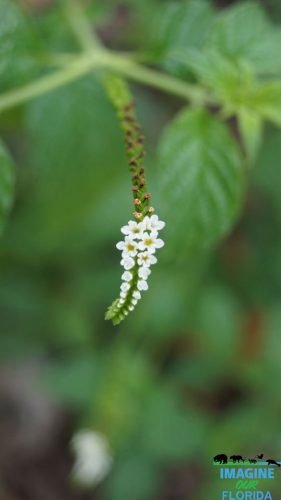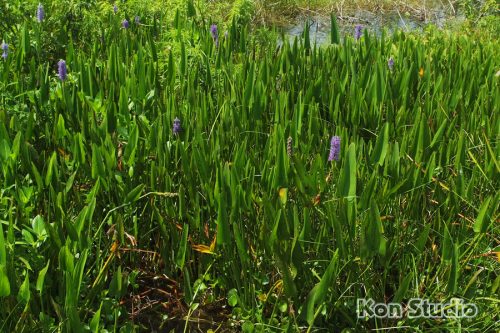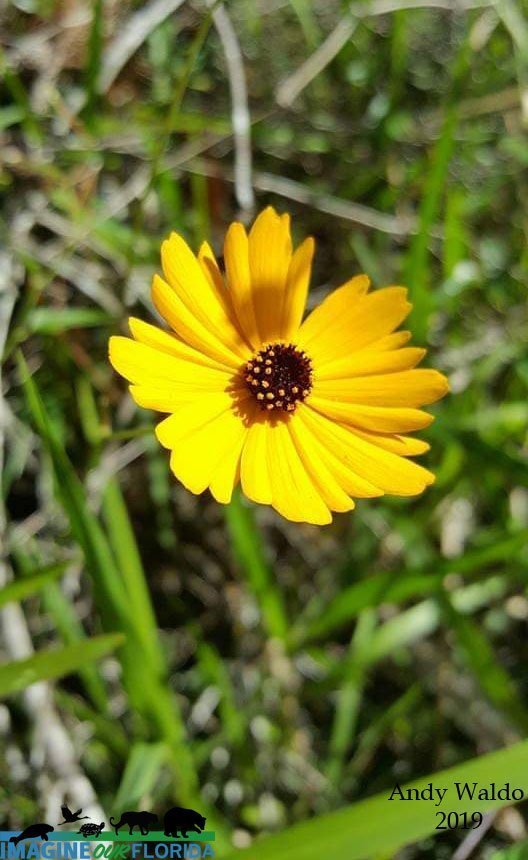Osceola’s Plume
American Lotus
Scorpion-tail
Scorpion-tail Heliotropium angiospermum
These delightful little plants are members of the Boraginaceae family which include common forget-me-nots. They can establish well in sandy and disturbed sites and are commonly found in coastal hammocks. They also make an excellent addition to your garden.
Orange Blossoms
The Orange Blossom from the sweet orange tree, Citrus x sinensis, was made Florida’s state flower in 1909. The sweet orange tree that bears this flower was introduced to Florida by the Spaniards in the 15th century. The orange tree is not endemic to Florida but has been naturalized.
Orange Blossom flowers have waxy petals that are small and white. Each flower has 5 petals with 20 to 25 stamens in a compact spiral. In the spring flowers grow in clusters of 6 flowers per cluster. Each flower is a point where an orange will grow in the spring. Orange Blossoms have a strong citrus scent and are an incredibly fragrant flower. The scent of the blossoms has been described as creamy, sweet, and rich, with a hint of a tart, citrus essence.
A full sunlight location and soil with a mixture of sand, clay, and organic matter is needed to produce these vibrant flowers. The orange tree begins to bloom at 2 to 5 years and blossoms can appear while there are oranges on the tree. The Orange Blossom is the only state flower used to make perfumes, colognes, toiletries herbal teas, and the ever-popular Orange Blossom Honey.
Did you know?
Throughout history, the Orange Blossom has come to symbolize good fortune and brides often include the fragrant blossoms in their bridal bouquets.
Photo credit: Aymee Laurain
Pickerelweed
Pickerelweed, Pontederia cordata, is a Florida native and is found throughout the state in shallow wetland areas, edges of lakes, marshes, and ponds. These plants have shiny green blade-shaped leaves and emerge in the springtime from under the water level. They will grow about 3 to 5 feet tall and flower with 3 to 4-inch purple-blue flower spikes. The individual flowers will only last one day but the plant will flower from spring through fall.
Pickerelweed is very important ecologically. The underwater portion of this plant provides habitats for micro and macroinvertebrates. These invertebrates are a food source for many animals and fish. Above the water, the flowers attract local pollinators such as butterflies, dragonflies, and bees, Once the flowers die the plant will bear fruit with seeds. The seeds are a treat for ducks who will at times, eat the whole plant. Pickerelweed holds and stabilizes the banks of the water bodies that they surround.
Pickerelweed would be a natural beauty when planted on the edge of man-made ponds in parks and HOAs, and on golf courses and other public places. Advocating for pickerelweed and other native aquatic plants would benefit pollinators and underwater species while beautifying your neighborhood naturally.
Fun fact – Pickerelweed’s fruit contains a nutritious seed that can be eaten by humans straight from the plant. The dried seed can be boiled, roasted, or ground into flour. Young leaves have been eaten in salads.
Florida tickseed
Florida State Wildflower
Florida tickseed (coreopsis floridana) is just one of Florida’s many diverse and beautiful wildflowers. This wildflower is endemic to Florida. It can be found throughout most of the state, except the extreme northern Panhandle counties. The Coreopsis was adopted as Florida’s State Wildflower in 1991.
Coreopsis grow best in wet open habitats such as the upper edges of marshes, savannas, and prairies. This is a robust fall bloomer and can stand 3 feet tall in ideal conditions. The petals are bright yellow, surrounding a dark disc. The flowers form a bloom that is two inches across. The leaves are narrow and elliptical in shape. This plant requires wet to moist soil to survive. In such settings, it blooms into showy, beautiful wildflowers.


















Recent Comments